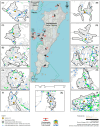Food Environment Around Schools in a Capital City in Southern Brazil: Changes in the Availability of Commercial Food Establishments Between 2012 and 2019
- PMID: 40566304
- PMCID: PMC12193097
- DOI: 10.3390/ijerph22060877
Food Environment Around Schools in a Capital City in Southern Brazil: Changes in the Availability of Commercial Food Establishments Between 2012 and 2019
Abstract
Objective: The objective of this article was to perform a comparative analysis of the changes in the availability of commercial food establishments around the schools in a Brazilian capital city.
Methods: This is a comparative analysis between two cross-sectional panels performed in 2012 and 2019 in Florianópolis, Santa Catarina, Brazil. Secondary data from different sources were used. The location data of schools and establishments were georeferenced. For the analysis of the surroundings of schools, a network buffer of 800 m was considered. The establishments were classified based on the foods they primarily sold: fresh, mixed and ultra-processed foods. The chi-square and Wilcoxon tests were applied for the analyses, considering a significance level of 95% (p < 0.05).
Results: The number of food establishments around schools increased by 63%. There was a statistically significant growth in mixed (p = 0.008) and ultra-processed (p = 0.024) food- selling establishments.
Conclusion: We conclude that the increase in establishments selling ultra-processed foods around schools at the expense of establishments selling fresh food deserves attention. This condition requires public policies that help promote healthier environments, thus contributing to the health of schoolchildren.
Keywords: built environment; community food environment; food retail; school environment; school health.
Conflict of interest statement
The authors declare no conflicts of interest.
Figures



Similar articles
-
Food environment around schools and adolescent consumption of unhealthy foods in Addis Ababa, Ethiopia.Matern Child Nutr. 2025 Jul;21 Suppl 1(Suppl 1):e13415. doi: 10.1111/mcn.13415. Epub 2023 Mar 31. Matern Child Nutr. 2025. PMID: 36999963 Free PMC article.
-
Feasibility study of Learning Together for Mental Health: fidelity, reach and acceptability of a whole-school intervention aiming to promote health and wellbeing in secondary schools.Public Health Res (Southampt). 2025 Jun 18:1-36. doi: 10.3310/RTRT0202. Online ahead of print. Public Health Res (Southampt). 2025. PMID: 40542530
-
Home treatment for mental health problems: a systematic review.Health Technol Assess. 2001;5(15):1-139. doi: 10.3310/hta5150. Health Technol Assess. 2001. PMID: 11532236
-
Education support services for improving school engagement and academic performance of children and adolescents with a chronic health condition.Cochrane Database Syst Rev. 2023 Feb 8;2(2):CD011538. doi: 10.1002/14651858.CD011538.pub2. Cochrane Database Syst Rev. 2023. PMID: 36752365 Free PMC article.
-
Nutritional labelling for healthier food or non-alcoholic drink purchasing and consumption.Cochrane Database Syst Rev. 2018 Feb 27;2(2):CD009315. doi: 10.1002/14651858.CD009315.pub2. Cochrane Database Syst Rev. 2018. PMID: 29482264 Free PMC article.
References
-
- Swinburn B., Sacks G., Vandevijvere S., Kumanyika S., Lobstein T., Neal B., Barquera S., Friel S., Hawkes C., Kelly B., et al. INFORMAS (International Network for Food and Obesity/non-communicable diseases Research, Monitoring and Action Support): Overview and key principles. Obes. Rev. 2013;14((Suppl. S1)):1–12. doi: 10.1111/obr.12087. - DOI - PubMed
-
- Atanasova P., Kusuma D., Pineda E., Frost G., Sassi F., Miraldo M. The impact of the consumer and neighbourhood food environment on dietary intake and obesity-related outcomes: A systematic review of causal impact studies. Soc. Sci. Med. 2022;299:114879. doi: 10.1016/j.socscimed.2022.114879. - DOI - PMC - PubMed
MeSH terms
Grants and funding
LinkOut - more resources
Full Text Sources

